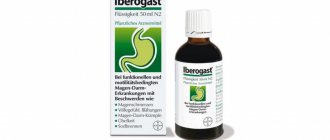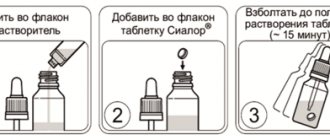Allergies are a fairly common problem. Sneezing, itching, inability to enjoy nature, animals and much more... It affects the general condition of a person, irritability, fatigue, and bad mood appear.
But now the pharmaceutical industry makes it possible to successfully combat the disease. Now allergy symptoms can be eliminated with the help of medications, one of which is Cetrin.
Allergy medications
Pharmacological properties
Pharmacodynamics
A competitive histamine antagonist, a metabolite of hydroxyzine, blocks histamine H1 receptors. Prevents the development and facilitates the course of allergic reactions, has antipruritic and antiexudative effects. Affects the early stage of allergic reactions, limits the release of inflammatory mediators at the “late” stage of the allergic reaction, reduces the migration of eosinophils, neutrophils and basophils. Reduces capillary permeability, prevents the development of tissue edema, relieves spasm of smooth muscles.
Eliminates skin reactions to the introduction of histamine, specific allergens, as well as to cooling (with cold urticaria). Reduces histamine-induced bronchoconstriction in mild bronchial asthma.
It has virtually no anticholinergic and antiserotonin effects.
In therapeutic doses it practically does not cause a sedative effect. The onset of the effect after a single dose of 10 mg of cetirizine is 20 minutes, lasts more than 24 hours. During the course of treatment, tolerance to the antihistamine effect of cetirizine does not develop. After stopping treatment, the effect lasts up to 3 days.
Pharmacokinetics
Rapidly absorbed from the gastrointestinal tract, the time to reach maximum concentration (TCmax) after oral administration is about 1 hour. Food does not affect the completeness of absorption (AUC), but prolongs TCmax by 1 hour and reduces the maximum concentration (Cmax) by 23% . When taken at a dose of 10 mg once a day for 10 days, the equilibrium concentration of the drug (Css) in plasma is 310 ng/ml and is observed 0.5–1.5 hours after administration. Plasma protein binding is 93% and does not change with cetirizine concentrations in the range of 25–1000 ng/ml. The pharmacokinetic parameters of cetirizine change linearly when administered at a dose of 5–60 mg. Volume of distribution – 0.5 l/kg.
In small quantities, it is metabolized in the liver by O-dealkylation to form a pharmacologically inactive metabolite (unlike other H1-histamine receptor blockers, which are metabolized in the liver with the participation of the cytochrome P450 system). Cetirizine does not accumulate. About 2/3 of the drug is excreted unchanged by the kidneys and about 10% in the feces.
Systemic clearance – 53 ml/min. The half-life (T1/2) in adults is 10 hours, in children 6–12 years old – 6 hours, 2–6 years old – 5 hours, 0.5–2 years old – 3.1 hours. In elderly patients, T1/2 increases by 50%, systemic clearance is reduced by 40% (decreased renal function).
In patients with impaired renal function (creatinine clearance below 40 ml/min), drug clearance decreases and T1/2 lengthens (for example, in patients on hemodialysis, the total clearance decreases by 70% and is 0.3 ml/min/kg , and T1/2 is extended by 3 times), which requires a corresponding change in the dosage regimen. It is practically not removed during hemodialysis.
In patients with chronic liver diseases (hepatocellular, cholestatic or biliary cirrhosis), an increase in T1/2 by 50% and a decrease in total clearance by 40% are observed (adjustment of the dosage regimen is required only with a concomitant decrease in glomerular filtration rate). Passes into breast milk.
pharmachologic effect
Cetrin belongs to the group of antiallergic drugs. Its therapeutic activity is based on the suppression of type H1 histamine receptors.
The drug has an antipruritic, antiexudative effect. Helps reduce swelling, local hyperemia and other local symptoms.
Cetrin can be used for a wide range of diseases. For rhinitis, it helps relieve a runny nose, nasal congestion, suppresses sneezing, itching and excessive lacrimation.
A special therapeutic effect is observed at the initial stage of the pathology. In the late stage, a decrease in the production of mediators is recorded. When Cetrin interacts with allergens, there is a decrease in vascular permeability, tissue swelling and muscle spasms.
There is no antiserotonin and anticholinergic effect. When taking a daily dosage of no more than 25 mg, cognitive ability is not impaired.
After a long course of treatment, drug dependence does not develop.
The components of the product are quickly absorbed by the digestive tract, the maximum time for the pharmacological effect to occur is 1 hour.
Use during pregnancy and breastfeeding
Pregnancy
When analyzing prospective data on pregnancy outcomes, no cases of malformations, embryonic and neonatal toxicity with a clear cause-and-effect relationship were identified.
Animal studies have not revealed any direct or indirect adverse effects of cetirizine on the developing fetus (including in the postnatal period), pregnancy and childbirth.
There have been no controlled clinical studies on the safety of the drug during pregnancy, therefore cetirizine should not be used during pregnancy.
Breast-feeding
Cetirizine is excreted in breast milk in concentrations representing from 25% to 90% of the drug concentration in the blood plasma, depending on the time of administration. During breastfeeding, the drug is used after consultation with a doctor, if the expected benefit to the mother outweighs the potential risk to the child.
Fertility
Available data on the effects on human fertility are limited, but no adverse effects on fertility have been identified.
What generations of antiallergic drugs exist?
First, let's figure out what generations of antihistamines exist. This is important, since the effectiveness of drugs and the ability to influence the central nervous system depend on the generation. The drugs include active substances - histamine receptor blockers. And as you know, histamine is responsible for the appearance of a reaction to an irritant (itching, redness, swelling, rashes), it is he who starts this process.
Today, there is a division of antiallergic drugs into generations. There are only three of them. Cetrin belongs to the second.
- I generation
Suprastin, Tavegil, Diazolin, Fenistil, etc. non-selective in their action on receptors. This means that they affect the central nervous system and gastrointestinal tract. Such indiscriminateness gives rise to a powerful antihistamine effect, but drowsiness appears as a “side effect”.
- II generation
Zyrtec, Zodak, Cetrin, Cetirizine, Parlazine, etc. have less effect on the central nervous system, since they are selective with respect to receptors. Accordingly, drowsiness as an adverse reaction is less pronounced. But with selectivity, the effectiveness of anti-allergy drugs disappears when compared with the first generation.
- III generation
Claritin, Erius, etc. characterized by high selectivity for histamine receptors. Drugs of this generation do not interact with the central nervous system, and such behavior entails the absence of drowsiness as a side reaction of the body. As for the effectiveness against allergies, these drugs are no lower than when compared with the first generation.
Directions for use and doses
Orally, regardless of food intake, without chewing, the tablets are taken with 200 ml of water.
Adults – 10 mg (1 tablet) 1 time a day or 5 mg (1/2 tablet) 2 times a day.
Children over 6 years old – 5 mg (1/2 tablet) 2 times a day or 10 mg (1 tablet) 1 time a day.
In patients with reduced renal function (creatinine clearance 30–49 ml/min), 5 mg/day (1/2 tablet) is prescribed, in severe chronic renal failure (creatinine clearance 10–30 ml/min) – 5 mg/day ( 1/2 tablet) every other day.
Instructions for use of Cetrin
The treatment regimen for Cetrin differs depending on the dosage form. The dose and course of therapy are determined by the doctor based on the diagnosis and age of the patient.
The drug in tablet form is intended for oral administration. They are drunk at any time of the day before or after meals, washed down with the required amount of water.
Adult patients are prescribed 10 mg of the drug per day once or divided into 2 approaches.
In case of kidney disease, the dosage is calculated individually. As a rule, it is reduced by half. In particularly severe conditions, tablets are taken every other day.
The drug in the form of syrup is taken orally, regardless of food. Adults are recommended 10 ml per day. It is recommended to start treatment with 5 ml. For pronounced symptoms, it is permissible to increase the dose to 20 ml per day.
Elderly patients and patients with liver dysfunction do not require therapeutic dosage adjustment.
In case of kidney disease, the treatment regimen is reviewed.
Benefits of the drug Cetrin
Cetrin is a second generation antiallergic drug. It is recommended to take it as an anti-inflammatory, as well as to prevent exacerbation of the disease.
The drug is based on cetirizine. This active substance prevents the formation of allergy symptoms (itching, swelling, pain, etc.). If you follow the dosage prescribed by your doctor, Cetrin will not cause drowsiness. The lack of sedative effect is due to the inability of cetrizine to penetrate the blood-brain barrier to the structures of the central nervous system.
By stopping itching, Cetrin indirectly prevents the development of skin infections, which often occur after scratching the area where the rash appears, or the itching of the skin is most active. It reduces the allergic response of the skin and bronchi, preventing the so-called atopic march, which is characterized by the evolution of dermatitis into bronchial asthma or rhinitis of an allergic nature.
Allergy
The therapeutic effect of taking Cetrin can be observed after twenty minutes, its duration is about a day. If you stop taking it, its echoes may be observed within three days. The effect will, of course, weaken. Thus, Cetrin:
- eliminates itching;
- relieves and prevents swelling;
- relieves spasm of smooth muscles;
- reduces capillary permeability and fluid release into tissues.
Also, the drug makes allergic rhinitis less painful. It relieves nasal congestion, stops exhausting sneezing, eliminates itching and excessive lacrimation.
In mild forms of bronchial asthma, Cetrin quite significantly reduces the number of attacks during the period of therapeutic treatment or, if there is a doctor’s indication for this, prophylaxis. It is worth noting that Cetrin is also good at relieving urticaria.
Indications
Cetrin syrup and tablets are effective for the following conditions:
- hay fever;
- allergic rhinitis/conjunctivitis;
- hives;
- allergic dermatoses with severe itching;
- Quincke's edema;
- atopic bronchial asthma.
Contraindications
Cetrin, both in the form of tablets and in the form of syrup, is prohibited from use in the presence of the following conditions:
- hypersensitivity or allergy to the active or auxiliary components of the drug (cetirizine, hydroxyzine);
- pregnancy period;
- breast-feeding;
- children under 2 years of age (for syrup);
- children under 6 years of age (for tablets);
- Cetrin syrup is not used in patients with calcium deficiency, intolerance to sucrose-isomaltose, fructose, or glucose/galactose malabsorption syndrome.
For patients with chronic renal failure and the elderly, the daily dose of Cetrin is selected individually. The therapeutic course is carried out under the supervision of the attending physician.
Side effects
Cetrin is quite well tolerated and does not often cause a negative response from the body. But still, after taking the drug, the following adverse reactions may be noted:
- headache;
- discomfort in the stomach/intestines (flatulence, abdominal pain, dyspepsia, flatulence, constipation, diarrhea);
- migraine;
- dizziness;
- hypersensitivity reactions (rash, itching, urticaria, Quincke's edema);
- dry mouth;
- drowsiness.
How to take Cetrin
Cetrin is taken orally, by mouth, without chewing, regardless of whether you eat or not. You should take the tablet with a small amount of clean water. Since Cetrin is rare, but causes drowsiness, and can be taken once a day, it is recommended to postpone its intake to the evening, and drink Cetrin before bed.
How to take Cetrin tablets correctly
The daily dose for an adult is 10 mg (10 ml of syrup). The maximum daily dose is 20 mg.
Syrup
- children over 6 years of age and adults: 10 ml of Cetrin syrup 1 time/day. or 2 times/day. 5 ml each;
- children 2-6 years old: 5 ml. 1 time/day or 2.5 ml 2 times/day;
- patients with reduced renal function: 5 ml 1 time/day, and in case of severe renal failure 5 ml of syrup every other day. Moreover, if the Clcr value does not exceed 10 ml/min, the use of the drug is contraindicated.
Pills
- children over 6 years of age and adults: 10 mg (1 tablet per day) 1 time / day. or 2 times/day. 1/2 tablet;
- patients with reduced renal function: the dose is selected individually. Usually the dose is reduced by 2 times, it is possible to use 1/2 tablet every other day. If Clcr does not exceed 30 ml/min, a dose of 5 mg should be taken every other day.
The exact dosage and duration of taking the drug is prescribed by the attending physician!
The clinical picture, symptoms and nature of the course of the disease determine the duration of therapy with Cetrin. To relieve an acute allergic reaction, the drug is taken for two weeks. At the same time, if the symptoms disappear before the specified period, stop taking Cetrin. However, it should be remembered that Cetrin can be continuously used as a therapeutic agent for no longer than 14 days.
If Cetrin is prescribed as a prophylaxis so that the allergy does not return with renewed vigor and in an acute form, then on average this course will last 1-1.5 months.
Cetrin also showed good results in the treatment of bronchial asthma. It is used as the basis for complex treatment of this disease. The course lasts 15-20 days, after which a week-long break is prescribed, then the drug is resumed. Children under 7 years of age who are prone to dermatitis take Cetrin 3-4 times a year. This course lasts about 10-14 days.
As for the combined use of Cetrin and alcohol, you should refrain from drinking alcoholic beverages during therapeutic treatment.



